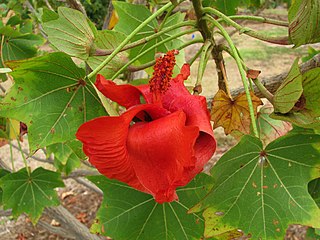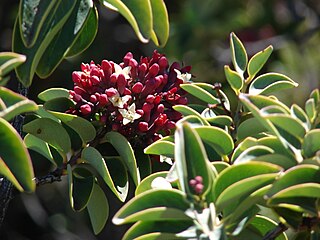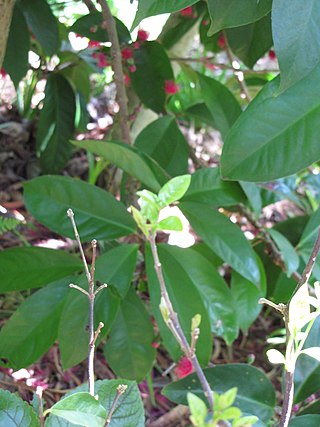Located about 2300 miles (3680 km) from the nearest continental shore, the Hawaiian Islands are the most isolated group of islands on the planet. The plant and animal life of the Hawaiian archipelago is the result of early, very infrequent colonizations of arriving species and the slow evolution of those species—in isolation from the rest of the world's flora and fauna—over a period of at least 5 million years. As a consequence, Hawai'i is home to a large number of endemic species. The radiation of species described by Charles Darwin in the Galapagos Islands which was critical to the formulation of his theory of evolution is far exceeded in the more isolated Hawaiian Islands.
Hawaiian hibiscus are seven species of hibiscus native to Hawaii. The yellow hibiscus is Hawaii's state flower. Most commonly grown as ornamental plants in the Hawaiian Islands are the non-native Chinese hibiscus and its numerous hybrids, though the native Hibiscus arnottianus is occasionally planted.

Hibiscadelphus distans is an extremely rare species of flowering plant in the mallow family, Malvaceae, that is endemic to the island of Kauaʻi in Hawaii. It is known as hau kuahiwi in Hawaiian, which means "upland Hibiscus tiliaceus." It is a bush or small tree with heart-shaped leaves and yellow flowers and grows at between 1,000 and 1,800 feet in the remnants of native dry forests. Despite its rarity, it is believed to be the only surviving species in the genus Hibiscadelphus which is only known from Hawaii, the other five species having recently become extinct in the wild, some being known from only a single plant.

Kokia cookei is a small, deciduous tree commonly known as the kokiʻo, Molokaʻi treecotton, Cooke's kokiʻo, or Molokaʻi kokiʻo.
Hibiscadelphus crucibracteatus is an extinct species of flowering plant in the family Malvaceae that was endemic to Hawaii, on the island of Lanai.

Hibiscadelphus giffardianus is a species of flowering plant in the mallow family Malvaceae that is endemic to the Big Island of Hawaii.

Hibiscadelphus hualalaiensis is a species of flowering plant in the mallow family Malvaceae that is endemic to the Big Island of Hawaii.
Hibiscadelphus woodii, or Wood's hau kuahiwi, is a species of flowering plant in the family Malvaceae endemic to Kauai, Hawaii.

Cenchrus agrimonioides is a rare species of grass in the family Poaceae that is endemic to the Hawaiian Islands. Its common names include Kāmanomano and agrimony sandbur. It was formerly distributed throughout the major islands but today it is nearly limited to Oʻahu. Kāmanomano inhabits dry to moist forests and lava plains. It is threatened by competition with non-native plants, predation by ungulates, and wildfire. When this plant became a federally listed endangered species of the United States in 1996 there were fewer than 100 individuals remaining. More recent counts revealed 181 wild individuals on Oʻahu and over 300 more which have been planted to augment the populations. This plant is nearly restricted to the island of Oʻahu, but there are a few individuals known on Maui. A few patches of the grass have been planted on Kahoʻolawe, as well.

Pritchardia forbesiana, the Mt. Eke pritchardia, is a species of palm tree. It is endemic to the island of Maui in Hawaii. It grows in forests. Populations are recovering since the removal of destructive feral pigs.

Melicope knudsenii, commonly known as Olokele Valley melicope or Knudsen's melicope, is a species of flowering plant in the family Rutaceae, that is endemic to Hawaii. It inhabits montane mesic forests dominated by Acacia koa, Metrosideros polymorpha, and Dicranopteris linearis on Kauaʻi and East Maui (Auwahi). Associated plants include Syzygium sandwicensis, Cheirodendron trigynum, Myrsine lessertiana, Ilex anomala, Alphitonia ponderosa, Zanthoxylum dipetalum, Kadua terminalis, Pleomele aurea, Bobea spp., Tetraplasandra waimeae, Xylosma hawaiensis, Eurya sandwicensis, Psychotria mariniana, Melicope anisata, Melicope barbigera, Planchonella sandwicensis, Dodonaea viscosa, and Dianella sandwicensis. It is threatened by habitat loss. Like other Hawaiian Melicope, this species is known as alani. This is a federally listed endangered species of the United States.

Santalum haleakalae, known as Haleakala sandalwood or ʻIliahi in Hawaiian, is a species of flowering tree in the sandalwood family, that is endemic to the islands of Maui, Lanai, and Molokai in the Hawaiian Islands, part of the United States. It grows in subalpine shrublands at elevations of 1,900 to 2,700 m, especially on the slopes of Haleakalā.

Wikstroemia bicornuta, the alpine false ohelo, is a species of flowering plant in the mezereon family, Thymelaeaceae, that is endemic to Hawaii. It inhabits mixed mesic and wet forests at elevations of 900–1,050 m (2,950–3,440 ft) on the islands of Lānaʻi and Maui. It is threatened by habitat loss.

Wikstroemia villosa, the hairy wikstroemia or hairy false ohelo, is a tropical species of plant in the Thymelaeaceae family.
Acaena exigua is an extinct species of flowering plant in the rose family known by the common name liliwai. It was endemic to Hawaii, where it was known from Kauaʻi and west Maui. It had not been seen or collected since 1957 and was feared extinct until 1997, when one plant was discovered in a remote montane bog on Maui. The plant died in 2000, and the species is now considered extinct.
Clermontia peleana is a rare species of flowering plant in the bellflower family known by the common name Pele clermontia. It is one of several Hawaiian lobelioids in genus Clermontia that are known as `oha wai. This plant is endemic to the island of Hawaii, where it is known from a few individuals. It is a federally listed endangered species of the United States.
Cyanea copelandii is a rare species of flowering plant in the bellflower family known by the common name treetrunk cyanea. It is endemic to Maui, where there are no more than 250 individuals remaining in the wild. It is a federally listed endangered species of the United States. Like other Cyanea it is known as hāhā in Hawaiian.
Cyanea glabra is a rare species of flowering plant in the family Campanulaceae known by the common name smooth cyanea. It is endemic to Maui, where there are twelve plants remaining in the wild. It was federally listed as an endangered species of the United States with nine other Maui Nui endemics in 1999. Like other Cyanea it is known as haha in Hawaiian.
Cyanea quercifolia, known as oakleaf cyanea, was a species of plant native to the Hawaiian island of Maui. The plant is now considered extinct, as its native habitat has been mostly destroyed, and no new individuals have been found.
Hibiscadelphus stellatus is a species of flowering plant in the mallow family, Malvaceae. It is called stellar hau kuahiwi in the United States Department of Agriculture PLANTS database. It is endemic to West Maui, Hawaii. It was first formally described in 2014. The specific epithet stellatus comes from the Latin for "star-shaped", referring to its stellate pubescence and the five, star-shaped involucral bracts, as well as its "beautiful and stellar (outstanding) flowers".












